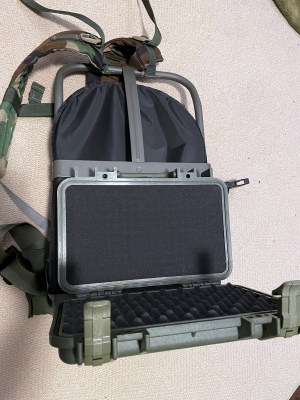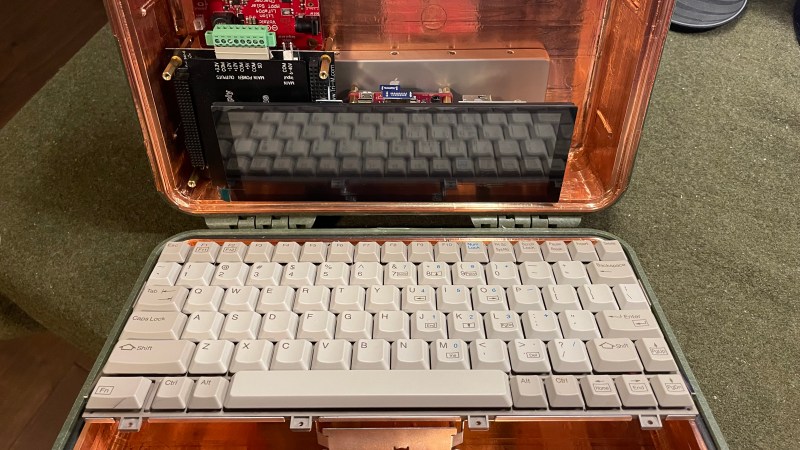The end of the world seems closer now than ever before, even in the 1980s. But you, dear Hackaday reader, will want more than just a bug-out bag full of C-rations and waterproof matches. You will need the technological version of a bug-out bag — a mil-spec-esque cyberdeck, which is exactly what [hammerandhandmi] is in the middle of perfecting.
 That’s not some kind of fancy cake pan — it’s a Pelican 1170 case lined with conductive foil tape. You see, [hammerandhandmi] has various reasons not elaborated upon for doing this, including EMP protection. Inside is an 8 GB Raspberry Pi 4B donning a Pi Juice UPS HAT and sipping from a fancy power supply. The main charging source for the old Mac book battery is solar via a large panel that’s external to cyberdeck. A smaller, secondary panel lives inside for backup purposes. There’s also an MPPT charge controller for to support the different battery chemistries. [hammerandhandmi] chose the Pelican 1170 because they need to mount it to the back of an LC2 Alice rucksack frame. The 1170 is wider than the popular 1150, and is in fact almost the exact width of the LC2 frame.
That’s not some kind of fancy cake pan — it’s a Pelican 1170 case lined with conductive foil tape. You see, [hammerandhandmi] has various reasons not elaborated upon for doing this, including EMP protection. Inside is an 8 GB Raspberry Pi 4B donning a Pi Juice UPS HAT and sipping from a fancy power supply. The main charging source for the old Mac book battery is solar via a large panel that’s external to cyberdeck. A smaller, secondary panel lives inside for backup purposes. There’s also an MPPT charge controller for to support the different battery chemistries. [hammerandhandmi] chose the Pelican 1170 because they need to mount it to the back of an LC2 Alice rucksack frame. The 1170 is wider than the popular 1150, and is in fact almost the exact width of the LC2 frame.
The point of this build is to maintain power for the purpose of preserving knowledge — all that stuff we’ll need to rebuild humanity. There will be much information available up via FOSS offline browser Kiwix, plus an atlas, some military field manuals, a lot of survival info, all of the books Project Gutenberg has to offer, plus a handful of movies and a few game ROMs so [hammerandhandmi] can live out the rest of their days in what is hopefully some kind of solar punk utopia.
Provided there’s enough time to implement it all, [hammerandhandmi] plans to add an SDR with antenna hookup, GPS unit, 12 V port, a couple of SSDs, a powered USB hub, and maybe an RFID reader. But the coolest part is that they ultimately want to connect everything up to a HUD mounted in a ballistic helmet. See? The apocalypse could be awesome. It’s up to us!
We often see cyberdecks with mechanical keyboards, like this cherry Pi number. But the salvaged keeb from a 1989 Compaq laptop might be just as future-proof.
















If you anticipate surviving an EMP event, I am not sure a GPS receiver is going to be helpful.
It will be useful for the first few months.
Why exactly? You expecting them to EMP the satellites in orbit?
As @Gravis stated. GPS without ground support will maintain accuracy, diminishing with time as ground-based corrections are no longer provided by EMP damaged ground stations. Whether the diminishing accuracy affects you will depend upon the application.
It’s a big jump from “an EMP is used somewhere” to “all GPS ground stations are EMP’d”. Plus I’d guess, given the military nature of GPS, that the ground stations might be hardened against an EMP?
The more interesting thought experiment is if you assume no ground station will ever issue corrections can you take your initial known GPS points from the beginning and create a functionally accurate GPS from the transmissions you do pick up (not entirely using the GPS satellite would seem like a winner there – the stuff in geostationary orbits with a sufficiently directional antenna could perhaps be used at least as a sanity check (there is enough of them up there I’d think with a little time sweeping you could position yourself to a good degree of accuracy, and there are enough other satellite up there broadcasting away that an orbital forecast map would probably do wonders – ‘oh there comes/goes that polar orbiting satellite again, that means it must be x pass over the horizon from this area at this hour so I must be so far east/west of where I was’…)
i mean yeah thats kind of how large scale emp work?
detention of a nuke in the upper atmosphere would wipe out all satellites in view of it as well as ground stations
Wipe out is probably overstating it – there will be a radius where that is true, but fairly quickly you hit the radius where its likely doing no permanent harm as the emp will have lost too much of its power – will undoubtedly make them throw a wobbly in some way, it might take them offline till the watchdog(s) resets them but most things in that outer radius would likely comeback unaided or be revive able from the ground, and the ground stations are likely to be up and running again in very short order.
It would have to be a really really really big single EMP to permanently kill everything over the horizon – for one thing most of the longer lived satalite are at least somewhat rad hard by design, then there is how stupendously far away the stuff in geostationary orbit is – and you would be able to see a vast number of those through the atmosphere from the altitude you suggested – those ones are almost certainly safe, even if the ones directly above you are not…
well the military studies showed that a single nuke driven emp would cover 90% of north American. and thats with it being attenuated by the atmosphere, in space it would be like a unexpected solar flare to everything not protected by the shadow of the planet.
most satellites need to be put into safe modes to survive that level of radiation so there would be a lot of damage
Oh no doubt about it there would be damage on a significant scale – that wasn’t my issue – its the everything it can see part that is – from the upper atmosphere sort of altitude (which is a very loosly defined range really) you would see a far vaster area of the ground than 90% of N.America and many satellites in geostatic orbits serving the other half of the world (as the world no longer takes up all that much of the field of view, its not quite a tiny blue dot, but you are getting there with the cone of shadow it casts being rather shrunken because of it) those satellites are a very very large distance away so probably safe from any real harm on that front alone, but with a huge thick chord of the atmosphere to get through too, which will likely protect most if not all of the lower orbits you can see on that side of the planet.
With setups like that you need to look at what parts have the shortest mean time to failure and supply spares or redundancy in some form. You also need to keep in mind that you will have very limited resources for servicing it. As for the preservation of useful knowledge, one thing I learned as a knowledge administrator for a large defence contractor was that there is a constant risk of hitting a tacit knowledge deficiency barrier because you did not appreciate the contributions individuals made to the end to end chain of actions required to complete a process successfully. i.e. Wikipedia is almost useless and should only be seen as a partial index to what you really need to know.
The flash memory on the Raspberry Pi is going to be the weakest point, as they tend to grind down SD cards to dust, and they’re not that reliable to begin with. There’s write disturbance, read disturbance, wear leveling issues, and there’s a limited data retention time even when the device is powered off.
A spinning magnetic disc would fare a good better chance of surviving in the long term.
Except most of those now have a helium atmosphere inside that diffuses within a few years, leading to head collision with the platter.
Optical would probably be best for read only info, as the manufacturer is estimating a one to two century lifespan on dvd-r. Now the drive itself is probably another matter entirely…
My experience with writable optical media is they love to delaminate even though they have never been exposed to extreme of temperature etc… Stamped/factory produced optical stuff might well last forever but I can’t see that any dvd-r will having had so many failures within a decade from many different brands etc…
From what I’ve seen the bog standard cheap audio cassette might be the best medium for longer term data survival – as Dad made many of them decades ago and not one of them has failed by itself outright (the player going wrong once did mean damage to a tape on removal), even though many of them were rubbish quality ones… (assuming you can still get them built they way they used to be – still a more useable form of magnetic storage than most, and one that a failed drive doesn’t actually matter all that much it will remain readable with a little effort)
As recent political disturbances have proven, in case of emergency ownership of fancy electronic toys can make you a prime target for mugging, even from relatives.
All the books of the project Gutenberg.
Oh my… being stuck with Sade and Shakespeare and many third-zone wirters gives me shrills. I think I would rather disappear at that point, then having to reboot in the Victorian era litterature.
I´d prefer many Linux repositories and a full github image.
My physics is rusty, but doesn’t your Faraday cage have to be grounded to make an effective EMP shield?